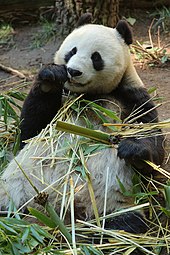Interspecific pregnancy
Interspecific pregnancy (literally pregnancy between species, also called interspecies pregnancy or xenopregnancy)
It has no known natural occurrence, but can be achieved artificially by transfer of embryos of one species into the womb of another.
Potential applications
Potential applications include carrying human fetuses to term as a potential yet ethically controversial alternative to human
Causes of failure
Immunologically, an embryo or fetus of an interspecific pregnancy would be equivalent to
Interspecies compatibility is related to the type of
Other potential hazards include incompatibility of nutrition or other support system. Notably, there is a risk of inappropriate interactions between the trophoblast of the fetus and the endometrium of the mother.[9] For example, the placental glycosylation pattern at the fetomaternal interface should optimally be similar to that of the host species.[10]
Yet, for some species, such as a Bactrian camel embryo inside a dromedary, pregnancy can be carried to term with no other intervention than the embryo transfer.[1][5] This is possible for gaur embryos inside cattle as well, but with severe intrauterine growth restriction, with uncertainty of how much is caused by the IVF procedure itself, and how much is caused by interspecies incompatibility.[2]
The ability of one species to survive inside the uterus of another species is in many cases unidirectional; that is, pregnancy would not necessarily be successful in the inverse situation where a fetus of the other species would be transferred into the uterus of the first one. For example, horse embryos survive in the donkey uterus, but donkey embryos perish in the uterus of an untreated mare.
Techniques
Overcoming rejection
Methods to artificially stimulate gestational immune tolerance towards a xeno-fetus include intercurrently introducing a component of a normal allogeneic pregnancy. For example, embryos of the species
On the other hand,

Embryo creation
Embryos may be created by
Explanatory notes
References
- ^ S2CID 30872357.
- ^ PMID 11354705.
- ^ a b Darwin's children LeVay, Simon. (1997, October 14). from The Free Library. (1997). Retrieved March 6, 2009
- ^ PMID 10729070.
- ^ S2CID 20825507.
- PMID 17132908.
- ^ PMID 3876431.
- S2CID 16661549.
- ^ on 2013-04-14. Retrieved 2010-10-09.
- PMID 19121542.
- ^ PMID 12135908. "Interspecies Implantation and Mitochondria Fate of Panda-Rabbit Cloned Embryos". Archived from the originalon 2015-09-23. Retrieved 2010-10-09.
- PMID 3488398.
- PMID 3610877.)
{{cite journal}}: CS1 maint: multiple names: authors list (link - S2CID 32648440.
- PMID 9378914.




